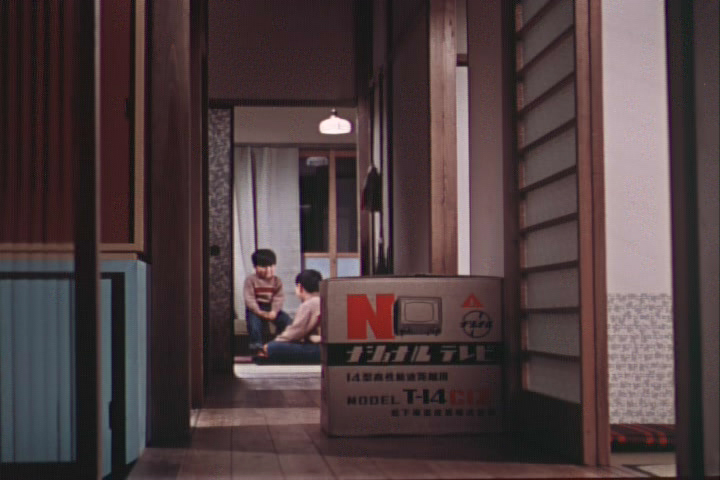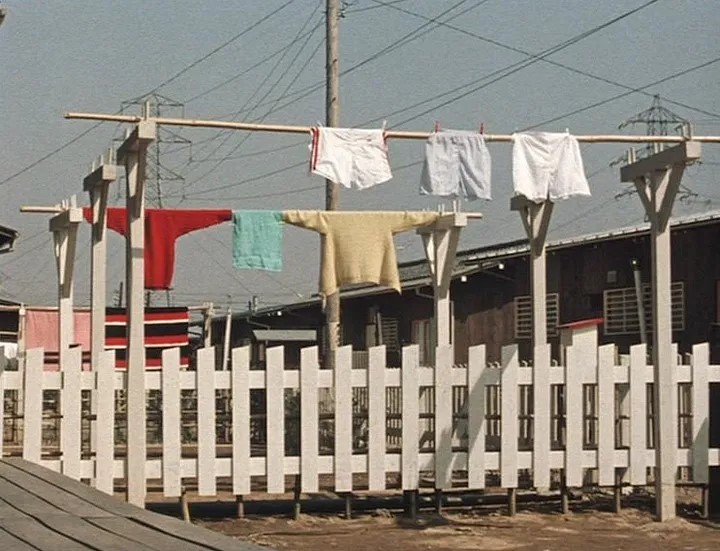| Nate Logsdon |

Good Morning plays on glorious 35mm at the Trylon Cinema from Friday, December 6th, through Sunday, December 8th. Visit trylon.org for tickets and more information.
Wim Wenders couldn’t find reality anywhere. In the Spring of 1983, he had traveled to Tokyo to mark the 20th anniversary of Yasujirō Ozu’s death. He was seeking the Japanese world that appeared so luminously in the films of that great director, whose body of work Wenders calls, in the resultant documentary Tokyo-ga, “a sacred treasure of the cinema.”
But that world was nowhere to be seen. In his search, Wenders trains his camera on a pachinko parlor, a recurring location in Ozu’s later work, but seems to become mesmerized to distraction by the glittering surfaces of the mechanical objects, as visually hooked to the game as the rows upon rows of seated players. He visits an urban driving range and considers the interest in golf manifested by various characters in Ozu’s world of business professionals, wondering at the obsession with swing technique detached from the actual game of golf. And, mostly pointedly, he stares with a detached, dreadful fascination at television screens.
While filming a small TV playing within a moving taxi, Wenders mournfully considers the discrepancy between what Ozu’s camera had shown him and what his own is now witnessing. “The more the reality of Tokyo struck me as a torrent of impersonal, unkind, threatening, yes even inhuman images,” he says in a voiceover, “the greater and more powerful became in my mind the images of the loving and ordered world of the mythical city of Tokyo that I knew from the films of Yasujiro Ozu. Perhaps that was what no longer existed: the view which still could achieve order in a world out of order. The view which could still render the world transparent.”
A television is also centered in Ozu’s delightful 1959 comedy Good Morning, playing at the Trylon December 6-8, in which a pair of brothers take a vow of silence to protest their parents’ refusal to buy a TV set for their home. The film is a loose re-working of one of the best movies of Ozu’s silent period, I Was Born But…. from 1932. The original, though made before the widespread adoption of television, likewise focuses on the disruptive role that technologically reproduced images play in families and society, with a plot that turns on a reel-to-reel home movie screening which presents two brothers with a view of their father at odds with their preferred vision. In these films, as in Wenders’ documentary seductively flickering screens insinuate themselves into the world, mediate and complicate human relationships, and threaten to tamper with a lucid perception of reality.
But Wenders’s statement also speaks to an alternative possibility for imagery and image-making technology—the possibility actualized by Ozu and his camera and transmitted to alert viewers through his carefully constructed films. And, somewhat inadvertently, Wenders alights on the essence of Ozu’s artistic means: the achievement of transparency through order. A chronological survey of Ozu’s work reveals the gradual development of formal techniques which eventually overtake his subject matter and become the central preoccupation of his mature work. He attains order through a consistent, rhythmic, and repetitive application of framing and composition standards that open and deepen the screen to generate an image that is not just seen but seen through: a transparent image.
The elements of Ozu’s late style are especially apparent when early and late period films are put side-by-side, as is natural to do with pairings like I Was Born But… and Good Morning, or A Story of Floating Weeds (1934) and Floating Weeds (1959)—silent films re-made in the post-war era. While it is possible to catalogue numerous individual differences, they can mostly be classified under two main headings: a replacement of motion by stillness and of action by absence.
If you immerse yourself in Ozu’s mature masterpieces like Tokyo Story, Late Spring, and Early Summer it can be downright jarring to check out his silents and suddenly see, say, panning. The post-war Ozu enshrined in official cinema memory is an artist who sets the camera at a low angle and then moves people into and out of the static frame. The composition has been created before any action occurs, human movement is in the service of that pre-determined visual arrangement (a point made clear by Ozu’s precise storyboards). This is clear in contrast with a film like I Was Born But… with its recurring tracking shots of the brothers being walked to school by their father; the camera moves with the characters, we’re in a human-oriented visual world. Compare that mobile view to Good Morning’s stationary long-shots of children on a distant horizon line passing through an opening in a row of houses on their way to school; by 1959, it’s a world’s world and we’re just living in it.
The late period films are all organized around those type of depth shots that could be still photographs until a person moves hurriedly through the far end of the perspectival field. Hallways, bar-filled back alleys, and rooms behind rooms behind rooms briefly house human forms and then revert to their natural emptiness. The viewer’s eye sinks through the two-dimensional screen by way of a telescopic effect generated by frames-within-frames (made of doorways, walls, and windows) sometimes up to four frames deep (or five counting the film frame). The shots are composed with a graphical attention to line, angle, and intersecting planes to create a dimensional reality.
These images are often included in Ozu’s famous segments of serene, suggestive, sometimes symbolic interstitial shots between scenes, memorably called “pillow shots” by Noël Burch, a term adapted from Japanese poetics.1 The critic-turned-master-filmmaker Paul Schrader refers to them as “coda shots,” a term adapted from music theory, and centers them in his account of Ozu’s “transcendental style,” which he relates to Zen artistic practices: “In Western art one would naturally assume that the codas are inserted to give weight to the paragraphs, but for Ozu, as for Zen, it is precisely the opposite: the dialogue gives meaning to the silence, the action to the still life.”2
Schrader here alludes to the dialogic potential of silence, an idea activated to comedic effect in Good Morning. The brothers’ refusal to speak is meant to both pressure their parents into buying a TV but also to rebel against meaningless adult chatter like “good morning” and “nice day, isn’t it?” Ozu cleverly shows the potential for silence to communicate and miscommunicate. On the first day of their protest, for instance, the brothers pass the house of a gossipy neighbor who misunderstands their snub as an expression of their mother’s disapproval of her—she’s instantly offended. Later, their English teacher and their aunt discuss the boys’ rejection of polite talk, initiating a flirtation that seems poised to blossom into a romance. And, most importantly with respect to their primary objective of watching sumo wrestling, the silent treatment ultimately results in their TV dreams coming true.
The brothers are among the many rebellious children in Ozu’s filmography, representatives of the intergenerational conflicts he explored in film after film. The source of rebellion in I Was Born But… is a home movie in which their father makes a fool of himself for the amusement of his boss. The boys don’t want to see their father that way. Anxiety over parentage and identity is also central to A Story of Floating Weeds and Floating Weeds. When an adult son is confronted by the father who abandoned him, he simply refuses to accept it; the idea he has of his father is incommensurate with the actual father standing before him. Another absent parent resurfaces in Tokyo Twilight (1957) causing confusion, disillusionment, and finally tragedy. But more often, Ozu is concerned with parents whose children have left them alone. Late in life loneliness might be the defining theme of Ozu’s post-war cinema, made visible at the unforgettable, and deliberately similar, endings of Late Spring, Tokyo Story, Late Autumn, and An Autumn Afternoon. Each film locates a tangible but abstract image of emptiness, giving form to absence.

But the ending of Good Morning is a bit of an outlier, not methodologically but tonally. The young family is united, whole, and happy. The new TV sits in a big box in the hallway. The boys resume their ongoing “pull-my-finger” (push-my-forehead, in this case) competition with their less talented friend. The English teacher and the boys’ aunt wait at a train station happily engaged in the exact small talk the brothers had denounced. And for the crucial final shot Ozu turns to a favorite image that has appeared in his films for decades, including I Was Born But…: laundry drying on a clothesline, with undergarments waving in the wind like flags at the League of Nations. But here, it is not only a serene vision of stasis, a meticulous composition emptied of human forms; it’s also a perfect punchline, a gentle visual joke. Have the perils of performative farting ever been more poetically rendered?
Footnotes
1 Leigh Singer, “The enigmatic ‘pillow shots’ of Yasujiro Ozu.” BFI, 8 September 2023, The enigmatic ‘pillow shots’ of Yasujiro Ozu | BFI
2 Paul Schrader, Transcendental Style in Film: Ozu, Bresson, Dreyer (Berkeley: Da Capo Press, 1972), 29.
Edited by Olga Tchepikova-Treon
